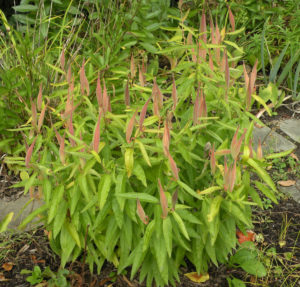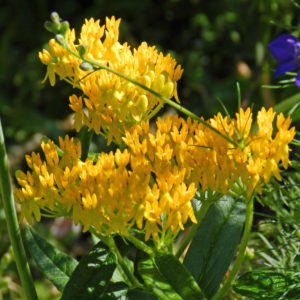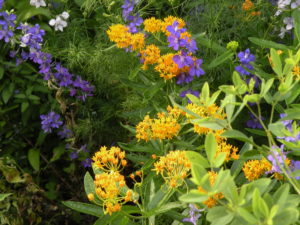
Asclepias tuberosa-finegardening.com
It is not surprising, with so much emphasis on increasing Monarch butterfly populations, that the Perennial Plant Association has chosen Asclepias tuberosa as its 2017 Perennial Plant of the Year. This perennial is known for its ability to support insects, birds, and pollinators.

Asclepias ‘Gay Butterflies’ colorful pods; taken in a client’s garden
The best-known member of the family is Asclepias tuberosa, commonly known as Butterfly Weed. Hardy from zones 4-9, it is slow to foliate in the spring but is easily identified later by its bright orange umbels that bloom in early June and on into July, if deadheaded, on two to three foot stems. The narrow leaves spiral up the hairy, stiff stems. Unlike other milkweeds, this one does not have milky sap in its stems. If the flowers are left on the plant after blooming, additional interest is provided by the spindle-shaped seed pods which split open when ripe, releasing numerous silky-tailed seeds for dispersal by the wind. If you do not wish to be the recipient of innumerable seedlings, these pods must be pruned off before they split.
The flowers are long-lasting as cuts for arrangements and so are the pods. Cut the stems when more than half the florets are open; buds do not open well once the stem is cut. Place immediately in warm water and then later in cold water to eliminate the little sap from seeping out into the water.

Asclepias ‘Hello Yellow’ closeup; taken in my garden
As a perennial with a deep tap root, Asclepias tuberosa is drought-resistant and thus a valuable plant for the sunny, dry garden, meadows, prairies, or naturalized/native plant areas. It is also perfect for a butterfly garden since the flowers are a nectar source for many butterflies and the leaves are a food source for monarch butterfly larvae (caterpillars). For those who can’t abide orange, there are now cultivars such as ‘Hello Yellow’, a golden yellow, which is slightly shorter than the species and ‘Gay Butterflies’ that is a mix of yellow, orange, and red-flowered forms.
This is a very low maintenance perennial, subject to no serious insect or disease problems. Happily, the deer usually ignore it.

Larkspur, Asclepias tuberosa ‘Hello Yellow’, taken in my garden
Butterfly Weed combines well with yellow Rudbeckia ‘Goldsturm’ as well as some of the Rudbeckia species that are found in meadows and prairies. For an eye-opening combination, plant Salvia ‘Caradonna’ in front of it. The combination of orange and purple is smashing.
If you are looking for a perennial for inclusion in a butterfly garden or a prairie garden, look no further. Asclepias tuberosa should be your plant of choice.


0 Comments